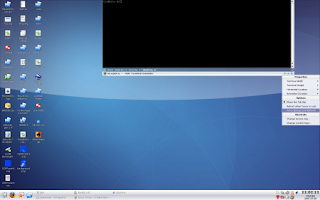 The interface is highly customizable, you can adjust the height, the width, the horizontal position you can change the keyboard shortcuts and make it retract automatically when it looses focus.
It uses the same terminal settings as Konsole and like Konsole it has multiple tabs so you can have more terminals running at the same time. If you exit KDE while YaKuake is still running in the background, it’ll start up automatically when you log back into KDE.
YaKuake is a very simple application, but it’s also very useful. I use it all the time when I want quick access to a terminal to run one or two commands, such as doing an apt-get update; apt-get upgrade, checking a man page to find the proper syntax for a command, or moving a few files around.
In ubuntu you can install YaKuake with a simple command
sudo apt-get install yakuake
YaKuake is released under GPL license and you can get it from the site:
* http://www.kde-apps.org/content/show.php?content=29153
The interface is highly customizable, you can adjust the height, the width, the horizontal position you can change the keyboard shortcuts and make it retract automatically when it looses focus.
It uses the same terminal settings as Konsole and like Konsole it has multiple tabs so you can have more terminals running at the same time. If you exit KDE while YaKuake is still running in the background, it’ll start up automatically when you log back into KDE.
YaKuake is a very simple application, but it’s also very useful. I use it all the time when I want quick access to a terminal to run one or two commands, such as doing an apt-get update; apt-get upgrade, checking a man page to find the proper syntax for a command, or moving a few files around.
In ubuntu you can install YaKuake with a simple command
sudo apt-get install yakuake
YaKuake is released under GPL license and you can get it from the site:
* http://www.kde-apps.org/content/show.php?content=29153
Access (K) ubuntu console with a single key
Posted by Gautam Aggarwal on Monday, December 29, 2008 The interface is highly customizable, you can adjust the height, the width, the horizontal position you can change the keyboard shortcuts and make it retract automatically when it looses focus.
It uses the same terminal settings as Konsole and like Konsole it has multiple tabs so you can have more terminals running at the same time. If you exit KDE while YaKuake is still running in the background, it’ll start up automatically when you log back into KDE.
YaKuake is a very simple application, but it’s also very useful. I use it all the time when I want quick access to a terminal to run one or two commands, such as doing an apt-get update; apt-get upgrade, checking a man page to find the proper syntax for a command, or moving a few files around.
In ubuntu you can install YaKuake with a simple command
sudo apt-get install yakuake
YaKuake is released under GPL license and you can get it from the site:
* http://www.kde-apps.org/content/show.php?content=29153
The interface is highly customizable, you can adjust the height, the width, the horizontal position you can change the keyboard shortcuts and make it retract automatically when it looses focus.
It uses the same terminal settings as Konsole and like Konsole it has multiple tabs so you can have more terminals running at the same time. If you exit KDE while YaKuake is still running in the background, it’ll start up automatically when you log back into KDE.
YaKuake is a very simple application, but it’s also very useful. I use it all the time when I want quick access to a terminal to run one or two commands, such as doing an apt-get update; apt-get upgrade, checking a man page to find the proper syntax for a command, or moving a few files around.
In ubuntu you can install YaKuake with a simple command
sudo apt-get install yakuake
YaKuake is released under GPL license and you can get it from the site:
* http://www.kde-apps.org/content/show.php?content=29153
Force Idle Status on Google Talk
Posted by Gautam Aggarwal on Friday, December 19, 2008Enabling the desktop cube in Ubuntu
Posted by Gautam Aggarwal on Monday, December 08, 2008In this article I assume,
That you have a working Internet connection.
That you have a faster graphics card with at leaset 64 MB of memory.
We need to follow the steps below.
Convert a Guest account into an Admin
Posted by Gautam Aggarwal on Sunday, December 07, 2008Windows keyboard tricks
Posted by Gautam Aggarwal on Saturday, December 06, 2008Change Drive Icon
Posted by Gautam Aggarwal on Monday, December 01, 2008Eg: c:\icon.ico
2.Then create a file called 'autorun.inf' in C: Drive.
Open that file and type the following:
___________________
[autorun]
icon=icon.ico
___________________
3.Save and close the file.
The icon will be changed!!!
Note: "autorun.inf" and "ico.ico" must be in the root of the drive. Eg: C:\autorun.inf and C:\icon.ico
Modify .exe files
Posted by Gautam Aggarwal on Saturday, November 22, 2008Learn how to change *.exe files, in 5 easy steps:
1) Don't try to modify a program by editing his source in a dissasembler. Why?
Cause that's for programmers and assembly experts only.
Try to view it in hex you'll only get tons of crap you don't understand.
First off, you need Resource Hacker. It's a resource editor-
very easy to use; you can download it at Download Recource-Hacker
2) Unzip the archive, and run ResHacker.exe. You can check out the help file too
3) You will see that the interface is simple and clean. Go to the menu File>Open or press Ctrl+O to open a file. Browse your way to the file you would like to edit. You can edit *.exe, *.dll, *.ocx, *.scr and *.cpl files, but this tutorial is to teach you how to edit *.exe files, so open one.
4) In the left side of the screen a list of sections will appear.
The most common sections are
-String table;
-RCData;
-Dialog;
-Cursor group;
-Bitmap;
-WAV.
*Icon: You can wiew and change the icon(s) of the program by double-clicking the icon section,chossing the icon, right-clicking on it an pressing "replace resource". After that you can choose the icon you want to replace the original with.
*String table: a bunch of crap, useful sometimes, basic programming knowledge needed.
*RCData: Here the real hacking begins. Modify window titles, buttons, text, and lots more!
*Dialog: Here you can modify the messages or dialogs that appear in a program. Don't forget to press "Compile" when you're done!
*Cursor group: Change the mouse cursors used in the program just like you would change the icon.
*Bitmap: View or change images in the programs easy!
*WAV: Change the sounds in the program with your own.
5) In the RCData, Dialog, Menu and String table sections you can do a lot of changes. You can modify or translate the text change links, change buttons, etc.
TIP: To change a window title, search for something like: CAPTION "edit this".
TIP: After all operations press the "Compile Script" button, and when you're done editing save, your work @ FileSave(Save as).
TIP: When you save a file, the original file will be backed up by default and renamed to Name_original and the saved file will have the normal name of the changed program.
TIP: Sometimes you may get a message like: "This program has a non-standard resource layout... it has probably been compressed with an .EXE compressor." That means that Resource Hacker can't modify it because of its structure.
Hide in the (Network) Neighbourhood
Posted by Gautam Aggarwal on Saturday, November 22, 2008Don't want your XP computer to show up in the network browse list (Network Neighborhood/My Network Places) to other users on your network? One way to accomplish that is to disable file sharing.
To do this, click Start, right click My Network Places and select Properties.
Right click your local area connection and click Properties.
Uncheck the box that says File and Printer Sharing for Microsoft Networks.
Click OK.
But what if you want to be able to share folders with some users; you just don't want everyone on the network to see your computer's shares? There's a way:
Click Start and select Run.
In the Run box, type net config server /hidden:yes
Click OK.
Now others who know the UNC path (\ \ computer name\ share name) can connect to your computer's shares from the Run box, but it won't show up in the network browse list.
Access Your Folders From Your Taskbar
Posted by Gautam Aggarwal on Monday, November 17, 2008This is an easy way to get to the folders on your system without having to open a Windows Explorer Window every time you want to access files. I find it very useful to have this feature as it allows me to access my Folders and Drives immediately and saves me a lot of time.
1. Right Click an empty spot on your Taskbar (Between your Start Button and your System Tray).
2. Click Toolbars.
3. Click New Toolbar.
4. A Small Window will Open that allows you to pick the folder you wish to make a Toolbar. If you want to access your Desktop Without having to minimize all your windows. Just Pick Desktop. If you want to access ONLY your My Documents Folder, Select that. Any folder will work for this.
5. Click OK.
The New Tool bar will appear at the bottom of your screen next to your System Tray.
If you find this to be not useful, Repeat Steps 1 and 2 and then check click the Toolbar you created that has a check mark next to it. And it will disappear.
Trace websites
Posted by Gautam Aggarwal on Saturday, November 15, 2008Bulk Editing Of .xxx to .zip or .mp3
Posted by Gautam Aggarwal on Sunday, November 09, 2008Lets us say you have just download a new album or game
but all the files are .xxx and you need them to be
zip's, rar's, mp3's etc.....
then do the following
-create a new folder
-put all the files needing editing in the new folder
-then goto "run" in the start menu
-type in CMD and click ok
-the next thing needs a few bits of old DOS commands
-you need to navigate CMD to the folder where the files are
-you can do this by first getting the total address of the folder
-and then typing it in cmd with a "cd" in front
QUOTE
cd c:\xxx\yyy\ccc\
once you in the folder where the files are you can move on..
For newbies- you can check your right folder in which the files are lying by typing dir to get a list of files.
-now type in....
QUOTE
rename *.* *.zip
Nb change the zip to what ever the extention needs to be (.rar, .mp3 etc)
all done
you should have now changed the .* to what ever you needed
happy downloading!!!
To exit CMD type in "exit"
Google Chrome's Keyboard Shortcuts
Posted by Gautam Aggarwal on Saturday, November 08, 2008Add / Remove Items from New Menu in Windows
Posted by Gautam Aggarwal on Wednesday, November 05, 2008Cool Things You Can Do With Google
Posted by Gautam Aggarwal on Sunday, November 02, 2008Turn Google Into a Quick Calculator Google enables you to perform a number of math operations including addition, subtraction, multiplication, division, and percentages. All you have to do is use some calculator operators, which include: + (addition) - (subtraction) * (multiplication) / (division) % of (percentage of) ^ (raise to a power) Here a few example queries to get you started. 23+34 120-43 36*20 27/3 36% of 134 3^9 (3 to the 9th power)
Take Notes while Browsing the Web with Google Notebook. This note taking application allows you to organize all of your online research quickly and easily. With Google Notebook, you can clip text, images, and links from web pages while browsing. Your notes and clips are saved to an online “notebook” that you can access from any computer, and may also be shared with others. So whether you’re planning a vacation or writing a school paper, Google Notebook makes it easy. To get started, go to Google Notebook’s main site.
Translate Foreign Sites A large portion of the web sites on the Internet are not in English. This means that you’re missing out on a big portion of the Web. Fortunately, Google has provided a solution. First, translate the word you want to search for into the desired language. You can do this at BabelFish. Next, go to Google, enter your search query, and press enter. On the results page, you should see a link that says, “Translate this page” to the right side of the search results. Click on that link and Google will automatically translate the page to English for you. I have used just this one tip to discover a number of great new sites that I never would have had access to if it weren’t for Google’s translation tools.
Looking for Movie Reviews? Google’s got you covered. Simply go to http://www.google.com/movies and type in your favorite movie. Here’s an example of my most recent search for Shrek the Third:
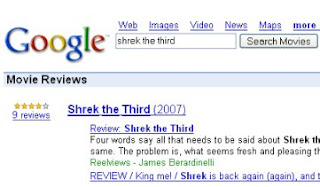 Google also has lots of specialized search portals catered to technology enthusiasts. Are you a Mac junkie? Google will allow you to search for all things related to Mac and Apple at http://www.google.com/mac. Search for all things Microsoft at http://www.google.com/microsoft. Not a Microsoft fan? Google’s got a special Linux search engine waiting for you at http://www.google.com/linux.
Google also has lots of specialized search portals catered to technology enthusiasts. Are you a Mac junkie? Google will allow you to search for all things related to Mac and Apple at http://www.google.com/mac. Search for all things Microsoft at http://www.google.com/microsoft. Not a Microsoft fan? Google’s got a special Linux search engine waiting for you at http://www.google.com/linux.Forget the Weather Channel. Who needs television when you’ve got Google? To get your local weather, simply go to www.google.com and type in weather:”areacode”. Fill in your area code and you will be given a 4-day weather forecast and today’s temperature, wind, and humidity.
Looking For a Stock Quote? Find it quickly at Google by typing in: “stocks:msft”. This search query will give you a quick snapshot of Microsoft’s stock performance. To find other stock information, just change the stock symbol.
Create your own Customized Google Search Engine. Google is allowing everyone to join in the fun with Google Custom Search Engines. This Google product allows anyone to create their very own search engine. You get to choose the sites, invite others to contribute to your search engine, and even customize the look and feel to suit your preferences. You could make your very own customized search for jobs, videos, digital camera reviews, and more. The possibilities are endless. Start building your own search engine at http://google.com/coop/cse/.
Hidden Google Pages There are also a number of hidden pages on Google that you’ve probably never seen before. Here are just a few of them: Google Moms - A tribute to Google moms for Mother’s Day. Google Dance 2004 , Google Dance 2005 and Google Dance 2006. Yes, it’s hard to believe, but Google has their very own dance. They’re packed with plenty of food, drinks, games, product demos, and a hotspot where you can meet the engineers. Google Holiday Logos - About the only thing that spices up the Google homepage are their cool logos. They’ve dedicated a special page to commemorate all of the holiday logos dating back to 1999. Dilbert and the Google Logo - Check out the first and last Dilbert cartoon on Google.
Get the local time of any place Not many people know that Google can also be used to get the local time of any place. To get the local time of the place of your choice follow the steps mentioned below. 1.) Point your browser to www.google.com 2.) In the search box type time
The Future of Google Google always has new ideas brewing in the Google Labs. Everything from Experimental Search to Google Voice Local Search. Find out what they’re up to at http://labs.google.com. Play around with their prototypes and then send in some feedback. Who knows, maybe we’ll see your ideas in the next Google tool. Feel free to post comments :)
ADD FIELDS TO THE DETAILS VIEW OF FOLDER
Posted by Gautam Aggarwal on Friday, October 24, 2008THE TRIPLE CLICK TRICK
Posted by Gautam Aggarwal on Friday, October 24, 2008How To Set Up Proxies In Your Browser
Posted by Gautam Aggarwal on Friday, October 24, 2008Use your pc as alarm
Posted by Gautam Aggarwal on Monday, October 20, 2008Services You Can Disable in Windows Vista
Posted by Gautam Aggarwal on Friday, October 17, 2008Changing the Location of the My Documents Folder
Posted by Gautam Aggarwal on Tuesday, October 14, 2008How to uninstall the Microsoft Java Virtual Machine (JVM)
Posted by Gautam Aggarwal on Friday, October 10, 2008Turning Off Vista's Built-In CD Burning
Posted by Gautam Aggarwal on Tuesday, October 07, 2008Adding the Internet Explorer Icon to the desktop in Vista
Posted by Gautam Aggarwal on Friday, October 03, 2008Adding Custom Sound Event in XP
Posted by Gautam Aggarwal on Wednesday, October 01, 2008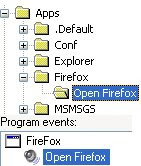 1. Go to Start –> Run, type Regedit
2. Go to HKEY_CURRENT_USER\AppEvents\Schemes\Apps
3. Right Click on Apps, New –> Key
4. Name the key with the programs EXE file, like Firefox for Firefox, Winword for Office word, without the extension
5. Now on right pane, right click Default, and click Modify and type in the same application name
6. Right click on new key and create a new key, and name whatever you want to
Custom Sound
7. Go to Control Panel –> Sounds and Audio devices –> Sounds, there you should be able to see the Custom sound event you added.
You can now assign any sound event you want to.
Do try it, an great tip to personalize your system more :)
1. Go to Start –> Run, type Regedit
2. Go to HKEY_CURRENT_USER\AppEvents\Schemes\Apps
3. Right Click on Apps, New –> Key
4. Name the key with the programs EXE file, like Firefox for Firefox, Winword for Office word, without the extension
5. Now on right pane, right click Default, and click Modify and type in the same application name
6. Right click on new key and create a new key, and name whatever you want to
Custom Sound
7. Go to Control Panel –> Sounds and Audio devices –> Sounds, there you should be able to see the Custom sound event you added.
You can now assign any sound event you want to.
Do try it, an great tip to personalize your system more :)
Mozilla Firefox Cool Stuff !!!
Posted by Gautam Aggarwal on Friday, September 26, 2008Disable Autorun
Posted by Gautam Aggarwal on Tuesday, September 23, 2008Google Chrome Cool Stuff
Posted by Gautam Aggarwal on Sunday, September 21, 2008Securing NTFS files and directories
Posted by Gautam Aggarwal on Friday, September 19, 2008Hidden Windows Vista Animation
Posted by Gautam Aggarwal on Tuesday, September 16, 2008SET A VIDEO AS YOUR WALLPAPER
Posted by Gautam Aggarwal on Friday, September 12, 2008Use Pen Drive as RAM
Posted by Gautam Aggarwal on Tuesday, September 09, 2008The Hard Drive Capacity Calculator
Posted by Gautam Aggarwal on Monday, September 08, 2008Windows Vista Error Fix:Windows Experience Index Doesn't Work
Posted by Gautam Aggarwal on Sunday, September 07, 2008Hidden Information and secret Things in Mozilla Firefox
Posted by Gautam Aggarwal on Saturday, September 06, 2008Google launches their new browser "Google Chrome"
Posted by Gautam Aggarwal on Wednesday, September 03, 2008How to back up and restore the registry in Windows
Posted by Gautam Aggarwal on Wednesday, September 03, 2008Increasing options in add/remove programs
Posted by Gautam Aggarwal on Wednesday, August 27, 2008Use check boxes to select files in Vista
Posted by Gautam Aggarwal on Tuesday, August 26, 2008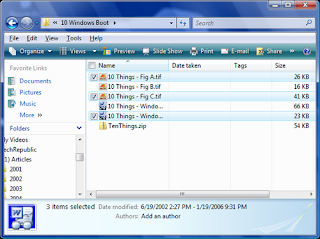 Now, when you hover your mouse pointer over the files in Windows Explorer, a check box will momentarily appear next each file as you move past it. If you select the check box, it will remain next to the file and the file will be selected. You can continue selecting files in this manner until you’ve selected all that you want, as shown in Figure. You’ll also notice that there is a check box in the Name column header. If you select that particular check box, all the files in that folder will be selected.
Now, when you hover your mouse pointer over the files in Windows Explorer, a check box will momentarily appear next each file as you move past it. If you select the check box, it will remain next to the file and the file will be selected. You can continue selecting files in this manner until you’ve selected all that you want, as shown in Figure. You’ll also notice that there is a check box in the Name column header. If you select that particular check box, all the files in that folder will be selected.
Check the license status in Windows Vista
Posted by Gautam Aggarwal on Saturday, August 23, 2008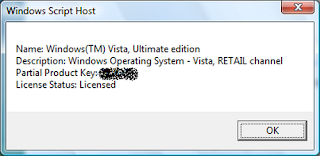 Windows Vista contains a little VBScript tool that will provide you with information about your license.
Windows Vista contains a little VBScript tool that will provide you with information about your license.
Check your Anti-Virus efficiency - Make a small virus yourself
Posted by Gautam Aggarwal on Wednesday, August 20, 2008Know about any process in windows with process explorer
Posted by Gautam Aggarwal on Monday, August 18, 2008Pause Your Boot Process
Posted by Gautam Aggarwal on Saturday, August 16, 2008Speed Up Folder Browsing
Posted by Gautam Aggarwal on Wednesday, August 13, 2008Use your NotePad As a Personal Diary
Posted by Gautam Aggarwal on Saturday, August 09, 2008GMail Drive
Posted by Gautam Aggarwal on Friday, August 08, 2008 In order for GMail Drive to operate, the computer must be connected to the Internet and the user must have a Gmail account. A broadband connection is preferable though not necessary, as all operations are done through Gmail and consequently over the Internet. GMail Drive uses the inbox of the Gmail account to store files and creates a virtual filesystem on top of the Gmail account, enabling the user to save and retrieve files stored on the Gmail account directly from inside Windows Explorer. GMail Drive adds a new virtual drive to the computer under the My Computer folder, where the user can create new folders, copy and drag-and-drop files to, but does not give an actual drive letter, such as C:, preventing its use in all DOS applications, and some older Windows applications.
Download GMail Drive from Softpedia
Feel free to post comments.
In order for GMail Drive to operate, the computer must be connected to the Internet and the user must have a Gmail account. A broadband connection is preferable though not necessary, as all operations are done through Gmail and consequently over the Internet. GMail Drive uses the inbox of the Gmail account to store files and creates a virtual filesystem on top of the Gmail account, enabling the user to save and retrieve files stored on the Gmail account directly from inside Windows Explorer. GMail Drive adds a new virtual drive to the computer under the My Computer folder, where the user can create new folders, copy and drag-and-drop files to, but does not give an actual drive letter, such as C:, preventing its use in all DOS applications, and some older Windows applications.
Download GMail Drive from Softpedia
Feel free to post comments.
Pidgin - A Powerful Universal Messenger
Posted by Gautam Aggarwal on Wednesday, August 06, 2008Create your own Run command
Posted by Gautam Aggarwal on Saturday, August 02, 2008Format USB Drive with NTFS File System
Posted by Gautam Aggarwal on Friday, August 01, 20082 Quick Windows Tricks
Posted by Gautam Aggarwal on Tuesday, July 29, 2008Make Orkut Free From Google Ads
Posted by Gautam Aggarwal on Friday, July 18, 2008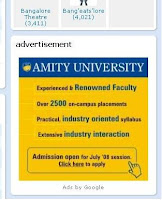
Orkut is one of social networking sites owned by Google. Though it's only popular in Brazil and India, but for some reason, Alexa says Orkut is the 9th most visited site in Ireland.
One thing which I have been annoyed of lately is the Google Ads shown by Google in the community homepage as this one.
But applying this trick you can free yourself from these ads in a cool place like Orkut.
Trick:
First and foremost requirement of this trick is that you should be using Mozilla Firefox. This Open Source piece of software is best software I've ever came across.
Fire your Firefox and proceed to this addon link -> AdBlock Plus. According to their developers
"Ever been annoyed by all those ads and banners on the internet that often take longer to download than everything else on the page? Install Adblock Plus now and get rid of them."
Click "Add to Firefox" and install the addon for your browser. Next step is restart your browser. Now everyone must be thinking how this can be called a trick when it comes to just installing a simple addon. Wait!!!
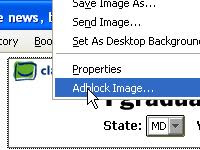
Whenever you want to block an ad, just right click it and click "AdBlock Image". But clicking all the ads inside Orkut is an impossible task because for that you have to search each and every community. But ever noticed that what is common with all these ads, their command format is
http://www.orkut.com/AdsIframe.aspx?xxxxxxx
This page is responsible for generating the Adsense code and placement of ads on pages.
Follow the next step and block all the Google ads. Right click any Google ads and click "Adblock Image". A box will popup and just enter "http://www.orkut.co.in/AdsIframe.aspx" . Bingo !!! You will blocked that main page which generates the ads.
This way you can block all the ads in Orkut. Liked the trick, I'll be waiting for your precious comments.


